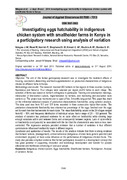| dc.contributor.author | Ndegwa, JM. | |
| dc.contributor.author | Mead, R. | |
| dc.contributor.author | Norrish, P. | |
| dc.contributor.author | Shephered, DD. | |
| dc.contributor.author | Kimani, CW. | |
| dc.contributor.author | Wachira, AM. | |
| dc.contributor.author | Siamba, Donald N. | |
| dc.date.accessioned | 2019-05-14T07:02:10Z | |
| dc.date.available | 2019-05-14T07:02:10Z | |
| dc.date.issued | 2014 | |
| dc.identifier.uri | http://dx.doi.org/10.4314/jab.v80i1.6 | |
| dc.identifier.uri | http://erepository.kibu.ac.ke/handle/123456789/962 | |
| dc.description.abstract | Objective: The aim of this farmer participatory research was to investigate the treatment effects of housing, vaccination, deworming and feed supplementation on production characteristics of indigenous chicken in different farms in Kenya.
Methodology and results: The research involved 200 farmers in five regions in three counties (Laikipia, Nyandarua and Nakuru). Four villages were selected per region and10 farms in each village. The selection of farms was based on farmer’s willingness to participate. Training and sensitisation meetings, introduction of intervention options, implementation by farmers, and monitoring and evaluation were carried out. The project was monitored over a span of five, 3-months long period. This paper has dwelt on the inferential statistical analysis of production characteristics hatchability, using variation analysis. The data used was from 107 and 121 farms recorded in three consecutive typical hen-cycles. The production characteristic hatchability was obtained as percentage of the eggs hatched over the eggs set for each hen that had records for each cycle. The mean hatchability values in the 20 villages ranged from 62 – 76% and frequency distribution of individual values had a range of 20 – 100 percent. The analysis of variation has produced evidence for no cycle effect on hatchability while showing large enough variations within and between farms and consequently between regions. Lack of cycle effects on hatchability could possibly be associated with the fact that the characteristic was more or less mancontrolled. The regression analysis provided evidence that a number of variables in four different combinations influenced hatchability levels in different regions.
Conclusion and application of results: The results of the analysis indicate that there is strong evidence that farmers’ actions, (management), animal behaviour (indigenous chicken hens genetic potential) and environment (regions) all have some influence on the performance of indigenous chicken flocks. This study also provides empirical evidence that farmer participatory research is a development concept that has great potential in supporting innovation and technology development and transfer for poverty alleviation and livelihoods enhancing of rural poor people. | en_US |
| dc.language.iso | en | en_US |
| dc.publisher | Elewa bioSciences | en_US |
| dc.rights | Attribution-NonCommercial-ShareAlike 3.0 United States | * |
| dc.rights.uri | http://creativecommons.org/licenses/by-nc-sa/3.0/us/ | * |
| dc.subject | Indigenous chicken system | en_US |
| dc.subject | Eggs hatchability | en_US |
| dc.subject | Smallholder farmers | en_US |
| dc.subject | Participation | en_US |
| dc.subject | Analysis of variation | en_US |
| dc.subject | Kenya | en_US |
| dc.title | Investigating eggs hatchability in indigenous chicken system with smallholder farms in Kenya in a participatory research using analysis of variation | en_US |
| dc.type | Article | en_US |

